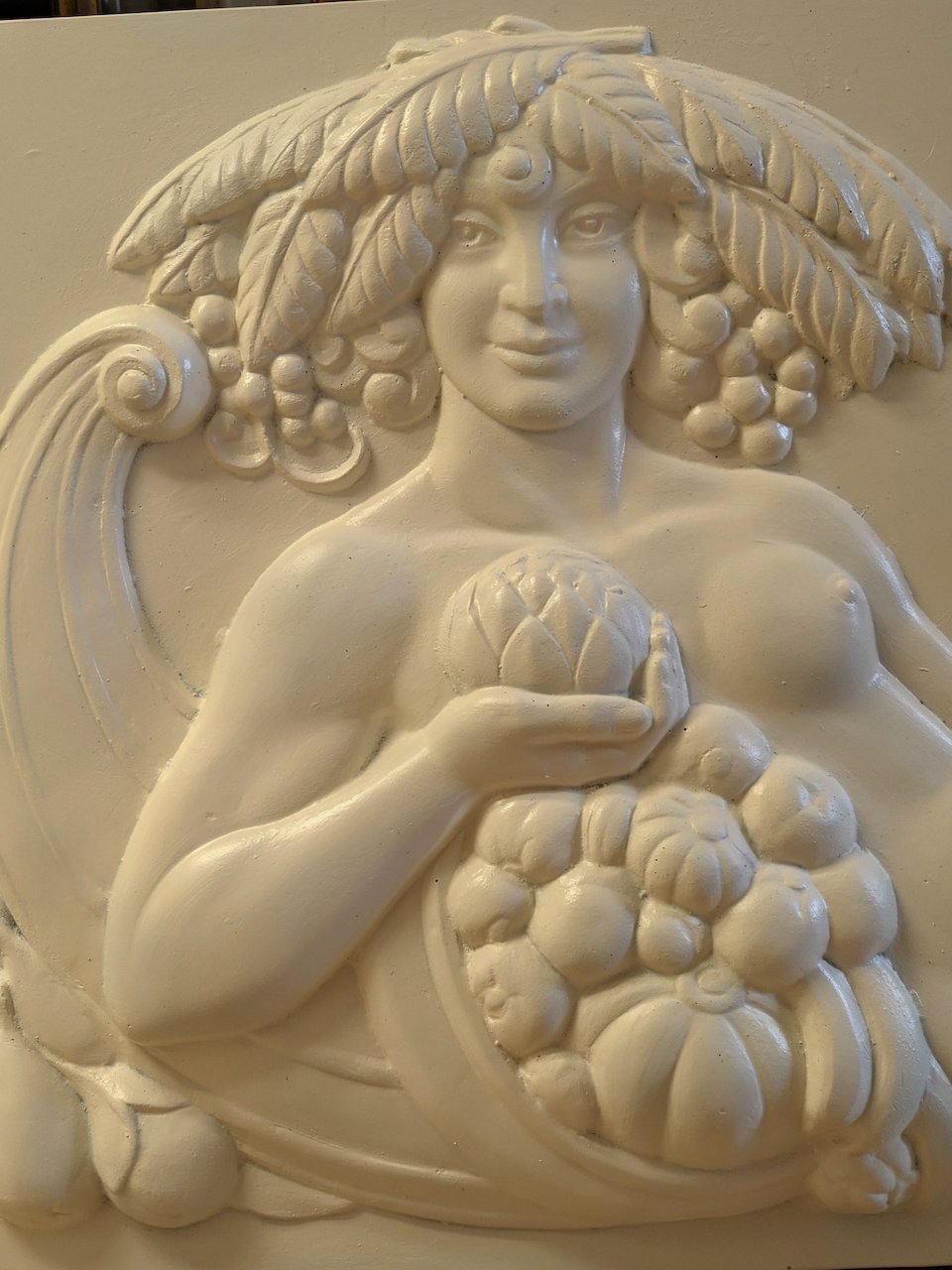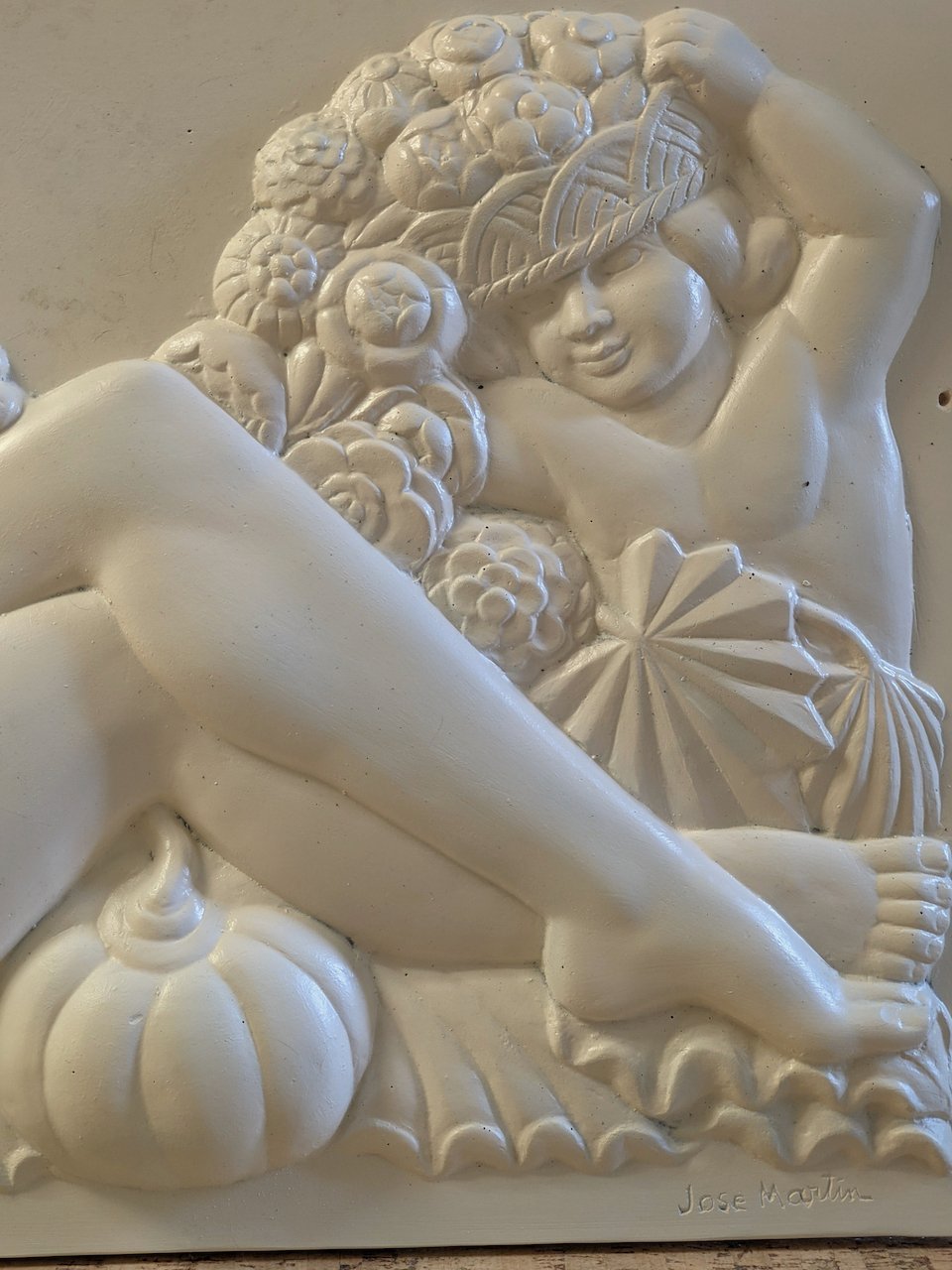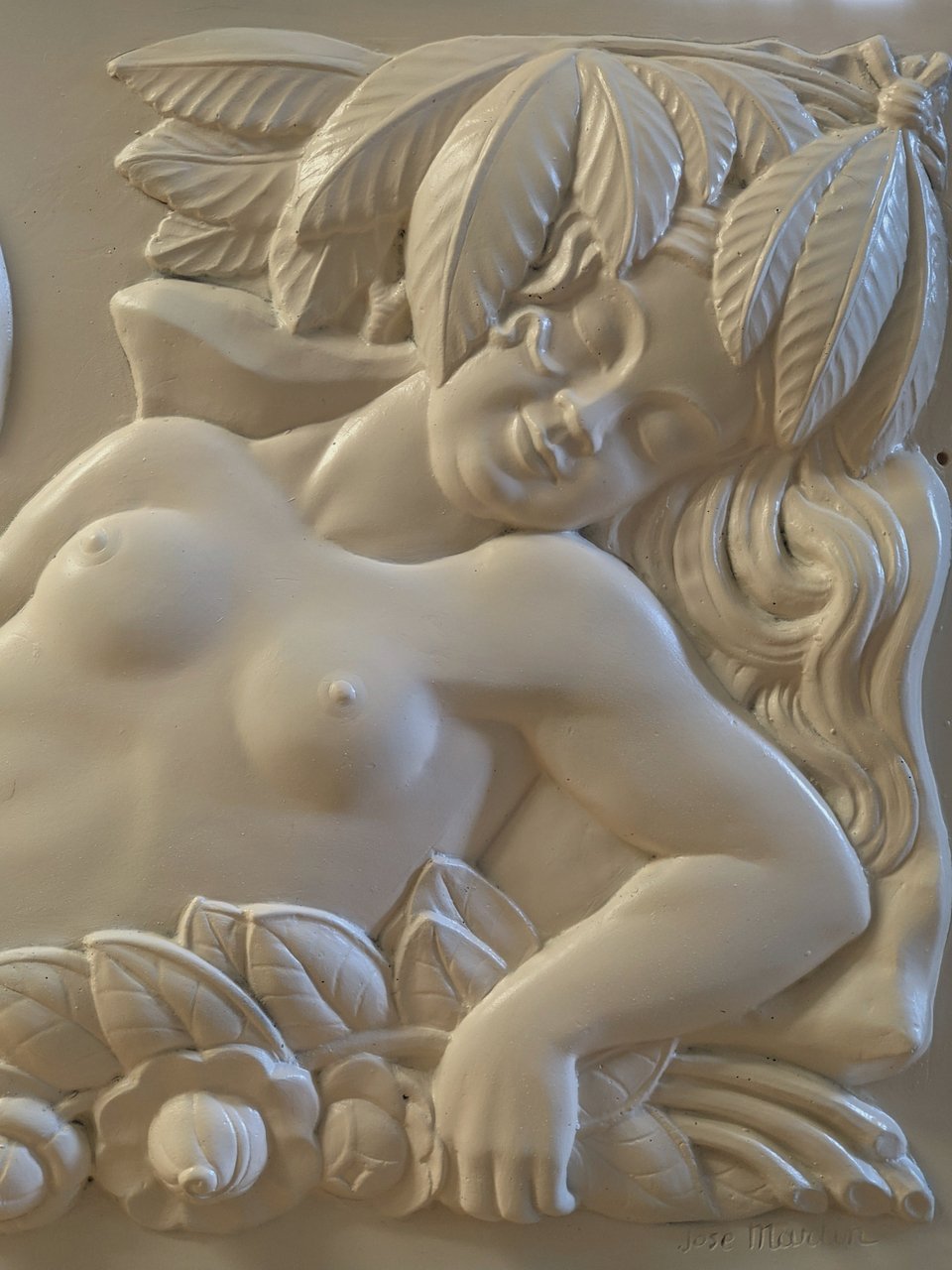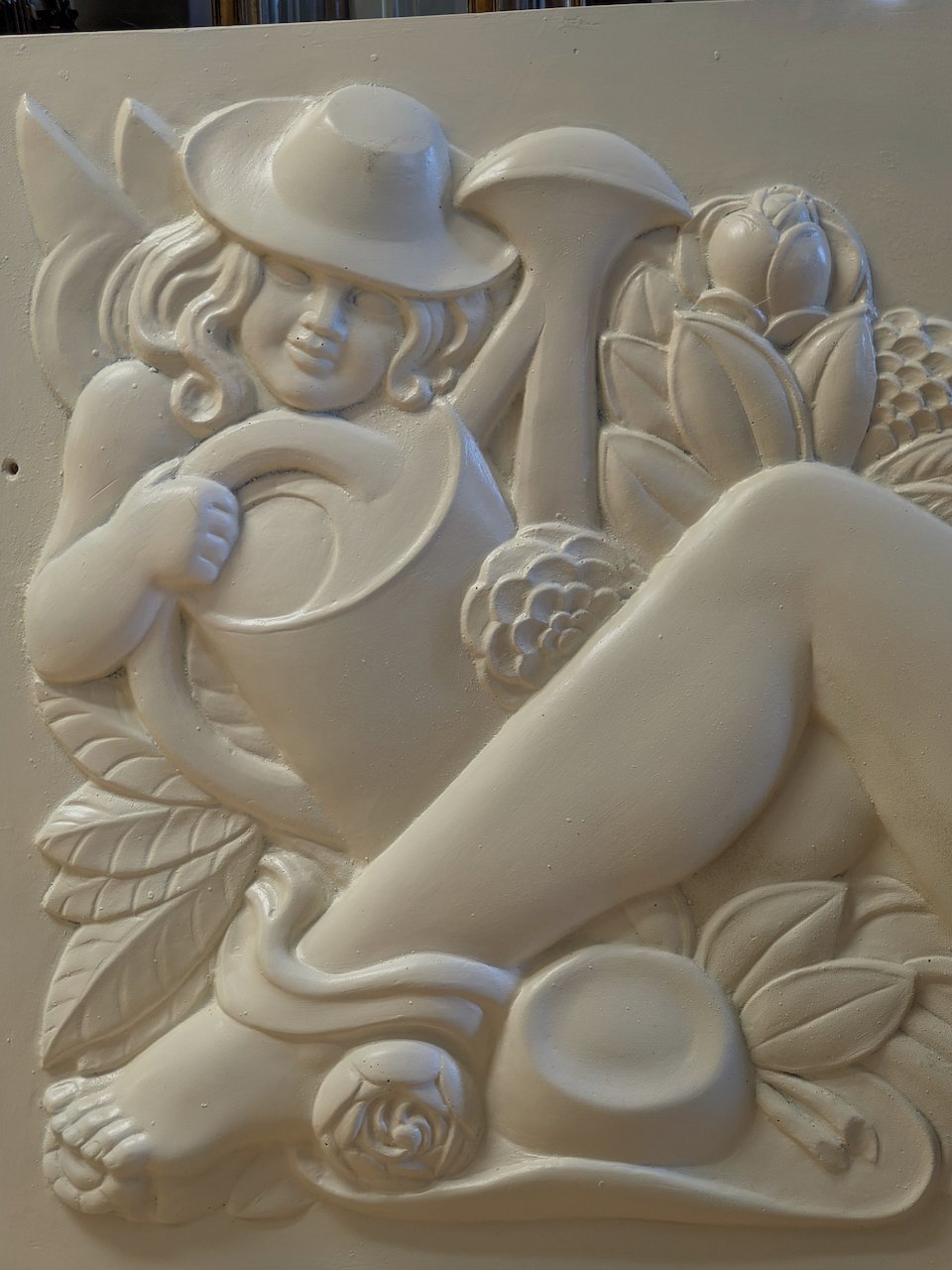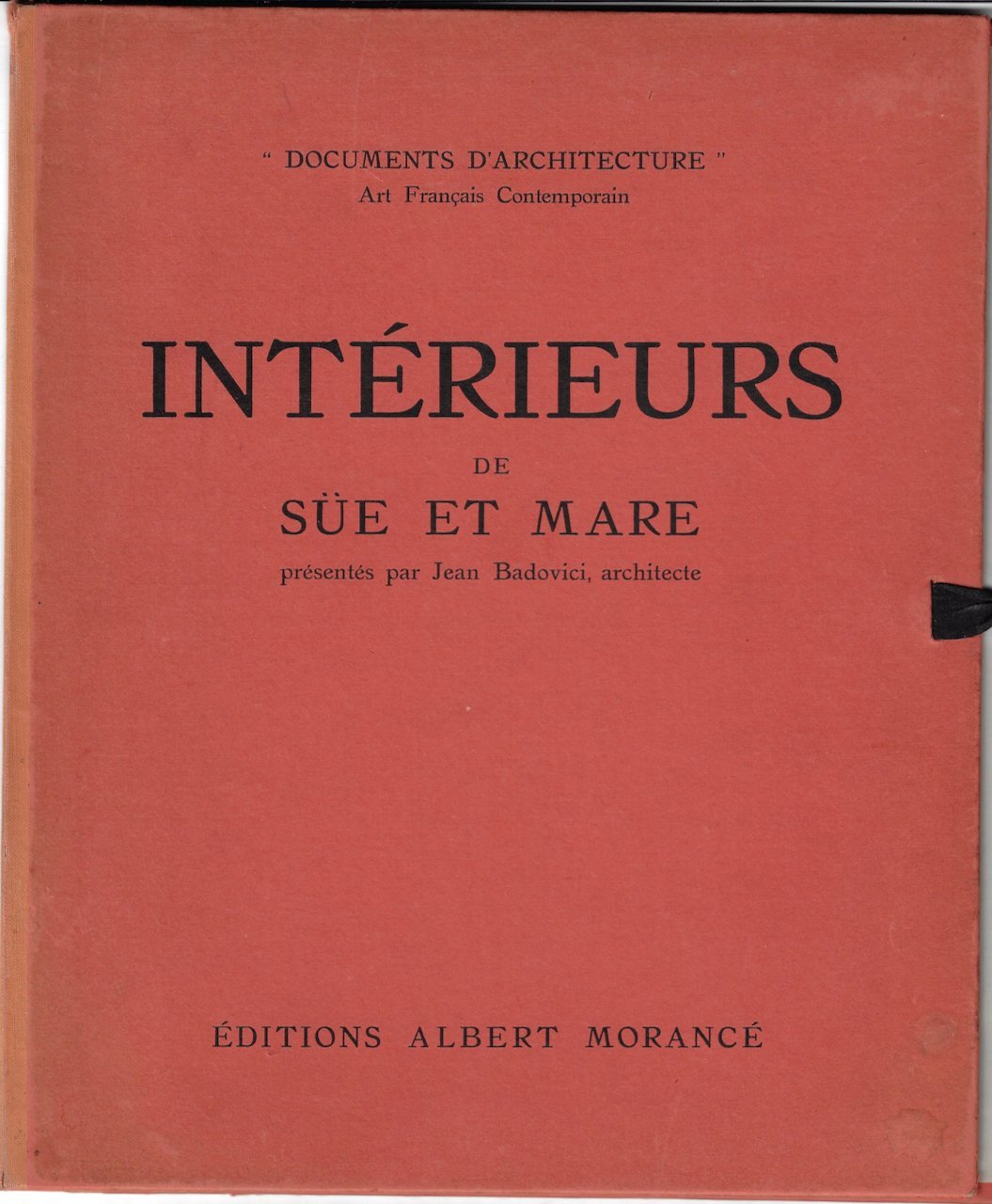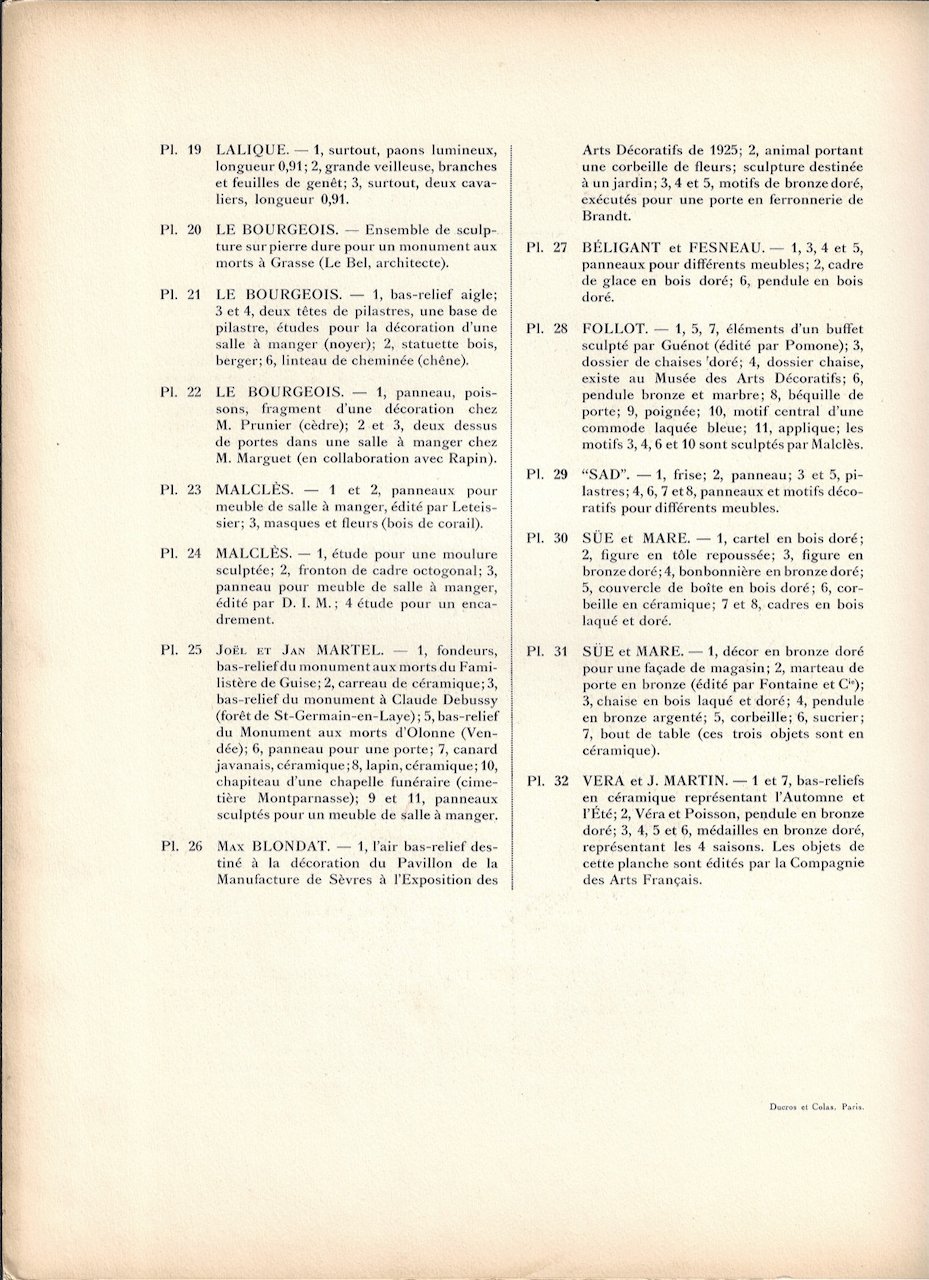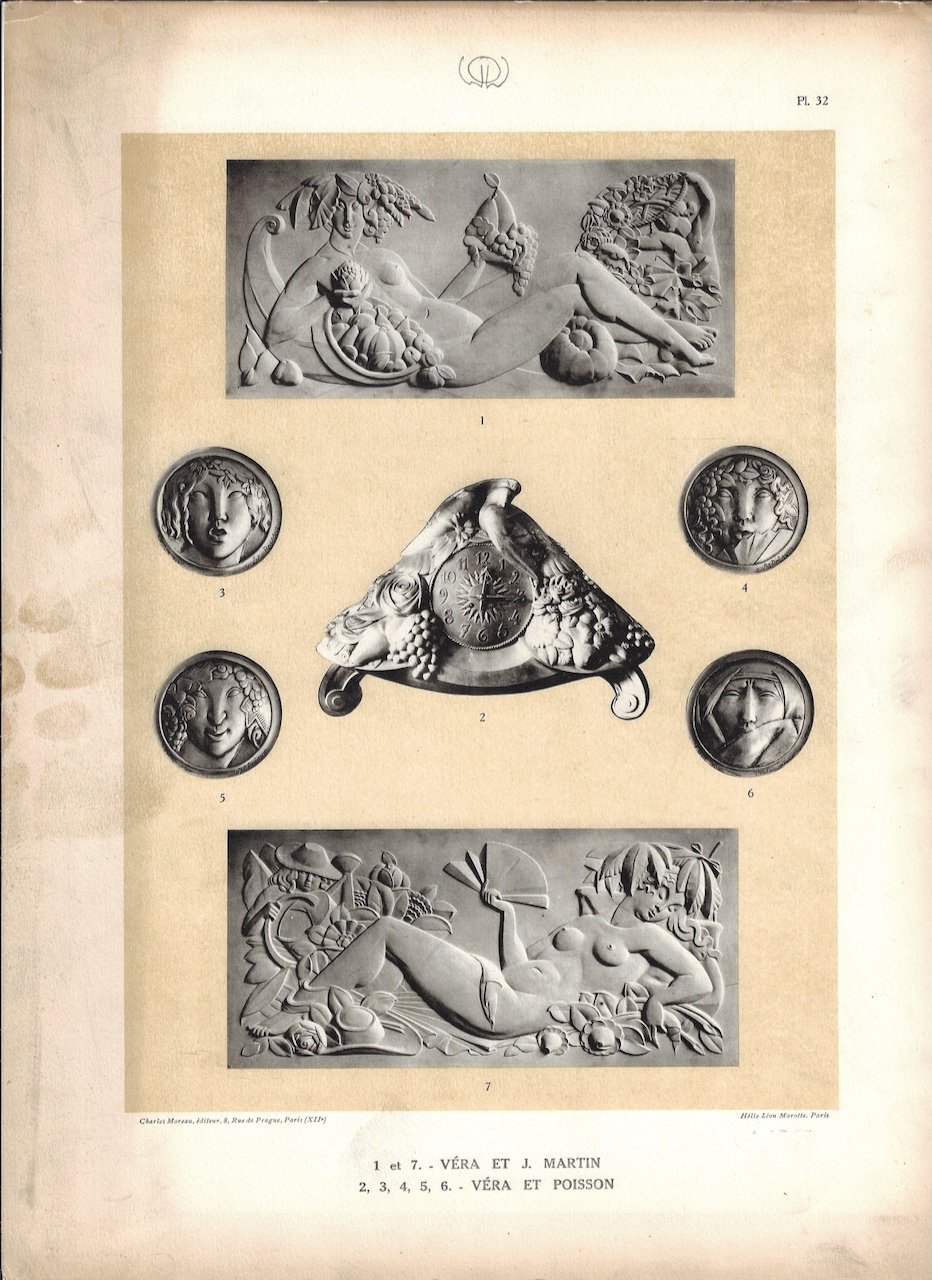Paul Vera/Jose Martin pair of bas relief panels (#1731)
Classic French Art Deco pair of plaster bas relief panels designed by Paul Vera, executed (and signed) by Jose Martin, for Sue et Mare’s La Compagnie des Arts Francais, circa 1925. 44” wide x 22” high. Similar to panels created for the Musee des Arts Decoratifs (see documentation photos).
PAUL VERA (1882-1958)
Paul Vera was a 20th Century French painter and decorator, active in Paris. He produced painted panels, bas-reliefs, printed fabrics, rugs, and illustrations. He often worked with Louis Sue and Andre Mare at their Compagnie des Arts Francais where he executed models for painted and sculpted decors, and for the Manufacture Nationale de Sevres. At the 1925 Paris Exposition Internationale des Arts Decoratifs et Industriels Modernes, Vera participated in several installations.
“It is the immutable principles of drawing and composition that we must penetrate, if we want to create anything that lasts . . . The secret of this robust art, it is Paul Vera who reveals it . . . The science (of math) has never hampered genuine originality. It is a means of test which makes it possible to distinguish pure gold from tinsel.”*
*Extrapolated from a 1921 review of The Modern Movement by Guillaume Janneau
MARTIN, José (1891-1985)
Joseph Camille Martin was born on April 27, 1891, at Miéry in the Jura district of France. Martin moved Paris to study at the School of Fine Arts (Ecole des Beaux-Arts). In 1919 he became a designer in the Company of French Arts [Compagnie des Arts français]. Founded by Louis Süe and André Mare, CAF was a were leader in the Art Deco style and participated in the International Exposition of 1925 in Paris. There, Martin collaborated with painter/decorator Paul Vera. Martin’s private work included assisting Antoine Sartorio in the execution of pediments for the Opera House at Marseille and of exterior décor for the Palace of the Mediterranean [Palais de la Méditerranée] at Nice. He also worked on the Alvear monument for the city of Sao Paulo, Brazil. Martin created by his own hand a monument to the dead at Danjoutin (Territoire de Belfort), as well as a work dedicated to Louis Pasteur in the village of Arbois (Jura).
In 1928 Martin moved to the United States and worked for some time in Chicago. From there he moved to Milwaukee and then on to the Cowan Pottery Company in Cleveland and later relocated to New York where he worked on ceiling decorations for the Waldorf Astoria Hotel. Returning to Chicago in 1932 he worked with Raoul Josset on a commission to create a group of sculptures for the 1933 “A Century of Progress” international exposition.
The two men created a sculpture for the Federal Building and four bas-reliefs representing the Departments of State, Treasury, Army, and Navy to decorate the fountain in the rotunda. In 1934, the two artists created a statue of the American Indian Chief, Tecumseh, and of his brother, Tenkswatawa, for the Lincoln Bridge in Vincennes, Indiana. Two years later the architect George Dahl commissioned Josset and Martin to work on ornamentation for the exposition that would celebrate the centennial anniversary of Texas’s independence from Mexico at Fair Park in Dallas.
José Martin settled in Dallas, where he officially became an American citizen on June 30, 1937. There the artist fulfilled many public and private commissions. In 1938 he created two statues of females that now flank the stage of the Lakewood Theater. He and his friend Josset collaborated in the creation of a statue of a sculpture for the Texan Scottish Rite Hospital for Crippled Children. In 1941 Martin carved two stone bas-reliefs to decorate the entrance of the Margaret B. Henderson Elementary School. In the same year he carved five stone bas-reliefs, after designs by Pierre Bourdelle, for the Baylor Medical Alumni Library. In 1942 Martin participated in World War II by settling in Seattle to work as a designer of combat airplanes within North American Aviation.
In 1946 he became a member of the new association of Texas artists. In 1947 Martin created a monument to the dead for the Restland Cemetery. Two years later he decorated the pediment over the entrance to the University Park Methodist Church with a bas-relief of Christ. In 1950, he executed in bronze a bust of Dr. George Truett, which today is on view in the large entrance hall of Baylor Hospital. In 1957 he came to the aid of Raoul Josset, who was experiencing difficulties in his realization of the plaster model for a statue of Sam Houston, destined for the Masonic Lodge in Waco. The artist is reputed to have created works for the Baker Hotel and various restaurants in Dallas. José Martin continued to work as a sculptor until the end of his life. He died in Dallas in 1985, at the age of 94.*
*Condensed and extrapolated from: French Sculpture Census, biography by Anne-Laure Garrec, Ecole du Louvre intern, 2011
Classic French Art Deco pair of plaster bas relief panels designed by Paul Vera, executed (and signed) by Jose Martin, for Sue et Mare’s La Compagnie des Arts Francais, circa 1925. 44” wide x 22” high. Similar to panels created for the Musee des Arts Decoratifs (see documentation photos).
PAUL VERA (1882-1958)
Paul Vera was a 20th Century French painter and decorator, active in Paris. He produced painted panels, bas-reliefs, printed fabrics, rugs, and illustrations. He often worked with Louis Sue and Andre Mare at their Compagnie des Arts Francais where he executed models for painted and sculpted decors, and for the Manufacture Nationale de Sevres. At the 1925 Paris Exposition Internationale des Arts Decoratifs et Industriels Modernes, Vera participated in several installations.
“It is the immutable principles of drawing and composition that we must penetrate, if we want to create anything that lasts . . . The secret of this robust art, it is Paul Vera who reveals it . . . The science (of math) has never hampered genuine originality. It is a means of test which makes it possible to distinguish pure gold from tinsel.”*
*Extrapolated from a 1921 review of The Modern Movement by Guillaume Janneau
MARTIN, José (1891-1985)
Joseph Camille Martin was born on April 27, 1891, at Miéry in the Jura district of France. Martin moved Paris to study at the School of Fine Arts (Ecole des Beaux-Arts). In 1919 he became a designer in the Company of French Arts [Compagnie des Arts français]. Founded by Louis Süe and André Mare, CAF was a were leader in the Art Deco style and participated in the International Exposition of 1925 in Paris. There, Martin collaborated with painter/decorator Paul Vera. Martin’s private work included assisting Antoine Sartorio in the execution of pediments for the Opera House at Marseille and of exterior décor for the Palace of the Mediterranean [Palais de la Méditerranée] at Nice. He also worked on the Alvear monument for the city of Sao Paulo, Brazil. Martin created by his own hand a monument to the dead at Danjoutin (Territoire de Belfort), as well as a work dedicated to Louis Pasteur in the village of Arbois (Jura).
In 1928 Martin moved to the United States and worked for some time in Chicago. From there he moved to Milwaukee and then on to the Cowan Pottery Company in Cleveland and later relocated to New York where he worked on ceiling decorations for the Waldorf Astoria Hotel. Returning to Chicago in 1932 he worked with Raoul Josset on a commission to create a group of sculptures for the 1933 “A Century of Progress” international exposition.
The two men created a sculpture for the Federal Building and four bas-reliefs representing the Departments of State, Treasury, Army, and Navy to decorate the fountain in the rotunda. In 1934, the two artists created a statue of the American Indian Chief, Tecumseh, and of his brother, Tenkswatawa, for the Lincoln Bridge in Vincennes, Indiana. Two years later the architect George Dahl commissioned Josset and Martin to work on ornamentation for the exposition that would celebrate the centennial anniversary of Texas’s independence from Mexico at Fair Park in Dallas.
José Martin settled in Dallas, where he officially became an American citizen on June 30, 1937. There the artist fulfilled many public and private commissions. In 1938 he created two statues of females that now flank the stage of the Lakewood Theater. He and his friend Josset collaborated in the creation of a statue of a sculpture for the Texan Scottish Rite Hospital for Crippled Children. In 1941 Martin carved two stone bas-reliefs to decorate the entrance of the Margaret B. Henderson Elementary School. In the same year he carved five stone bas-reliefs, after designs by Pierre Bourdelle, for the Baylor Medical Alumni Library. In 1942 Martin participated in World War II by settling in Seattle to work as a designer of combat airplanes within North American Aviation.
In 1946 he became a member of the new association of Texas artists. In 1947 Martin created a monument to the dead for the Restland Cemetery. Two years later he decorated the pediment over the entrance to the University Park Methodist Church with a bas-relief of Christ. In 1950, he executed in bronze a bust of Dr. George Truett, which today is on view in the large entrance hall of Baylor Hospital. In 1957 he came to the aid of Raoul Josset, who was experiencing difficulties in his realization of the plaster model for a statue of Sam Houston, destined for the Masonic Lodge in Waco. The artist is reputed to have created works for the Baker Hotel and various restaurants in Dallas. José Martin continued to work as a sculptor until the end of his life. He died in Dallas in 1985, at the age of 94.*
*Condensed and extrapolated from: French Sculpture Census, biography by Anne-Laure Garrec, Ecole du Louvre intern, 2011
Classic French Art Deco pair of plaster bas relief panels designed by Paul Vera, executed (and signed) by Jose Martin, for Sue et Mare’s La Compagnie des Arts Francais, circa 1925. 44” wide x 22” high. Similar to panels created for the Musee des Arts Decoratifs (see documentation photos).
PAUL VERA (1882-1958)
Paul Vera was a 20th Century French painter and decorator, active in Paris. He produced painted panels, bas-reliefs, printed fabrics, rugs, and illustrations. He often worked with Louis Sue and Andre Mare at their Compagnie des Arts Francais where he executed models for painted and sculpted decors, and for the Manufacture Nationale de Sevres. At the 1925 Paris Exposition Internationale des Arts Decoratifs et Industriels Modernes, Vera participated in several installations.
“It is the immutable principles of drawing and composition that we must penetrate, if we want to create anything that lasts . . . The secret of this robust art, it is Paul Vera who reveals it . . . The science (of math) has never hampered genuine originality. It is a means of test which makes it possible to distinguish pure gold from tinsel.”*
*Extrapolated from a 1921 review of The Modern Movement by Guillaume Janneau
MARTIN, José (1891-1985)
Joseph Camille Martin was born on April 27, 1891, at Miéry in the Jura district of France. Martin moved Paris to study at the School of Fine Arts (Ecole des Beaux-Arts). In 1919 he became a designer in the Company of French Arts [Compagnie des Arts français]. Founded by Louis Süe and André Mare, CAF was a were leader in the Art Deco style and participated in the International Exposition of 1925 in Paris. There, Martin collaborated with painter/decorator Paul Vera. Martin’s private work included assisting Antoine Sartorio in the execution of pediments for the Opera House at Marseille and of exterior décor for the Palace of the Mediterranean [Palais de la Méditerranée] at Nice. He also worked on the Alvear monument for the city of Sao Paulo, Brazil. Martin created by his own hand a monument to the dead at Danjoutin (Territoire de Belfort), as well as a work dedicated to Louis Pasteur in the village of Arbois (Jura).
In 1928 Martin moved to the United States and worked for some time in Chicago. From there he moved to Milwaukee and then on to the Cowan Pottery Company in Cleveland and later relocated to New York where he worked on ceiling decorations for the Waldorf Astoria Hotel. Returning to Chicago in 1932 he worked with Raoul Josset on a commission to create a group of sculptures for the 1933 “A Century of Progress” international exposition.
The two men created a sculpture for the Federal Building and four bas-reliefs representing the Departments of State, Treasury, Army, and Navy to decorate the fountain in the rotunda. In 1934, the two artists created a statue of the American Indian Chief, Tecumseh, and of his brother, Tenkswatawa, for the Lincoln Bridge in Vincennes, Indiana. Two years later the architect George Dahl commissioned Josset and Martin to work on ornamentation for the exposition that would celebrate the centennial anniversary of Texas’s independence from Mexico at Fair Park in Dallas.
José Martin settled in Dallas, where he officially became an American citizen on June 30, 1937. There the artist fulfilled many public and private commissions. In 1938 he created two statues of females that now flank the stage of the Lakewood Theater. He and his friend Josset collaborated in the creation of a statue of a sculpture for the Texan Scottish Rite Hospital for Crippled Children. In 1941 Martin carved two stone bas-reliefs to decorate the entrance of the Margaret B. Henderson Elementary School. In the same year he carved five stone bas-reliefs, after designs by Pierre Bourdelle, for the Baylor Medical Alumni Library. In 1942 Martin participated in World War II by settling in Seattle to work as a designer of combat airplanes within North American Aviation.
In 1946 he became a member of the new association of Texas artists. In 1947 Martin created a monument to the dead for the Restland Cemetery. Two years later he decorated the pediment over the entrance to the University Park Methodist Church with a bas-relief of Christ. In 1950, he executed in bronze a bust of Dr. George Truett, which today is on view in the large entrance hall of Baylor Hospital. In 1957 he came to the aid of Raoul Josset, who was experiencing difficulties in his realization of the plaster model for a statue of Sam Houston, destined for the Masonic Lodge in Waco. The artist is reputed to have created works for the Baker Hotel and various restaurants in Dallas. José Martin continued to work as a sculptor until the end of his life. He died in Dallas in 1985, at the age of 94.*
*Condensed and extrapolated from: French Sculpture Census, biography by Anne-Laure Garrec, Ecole du Louvre intern, 2011




